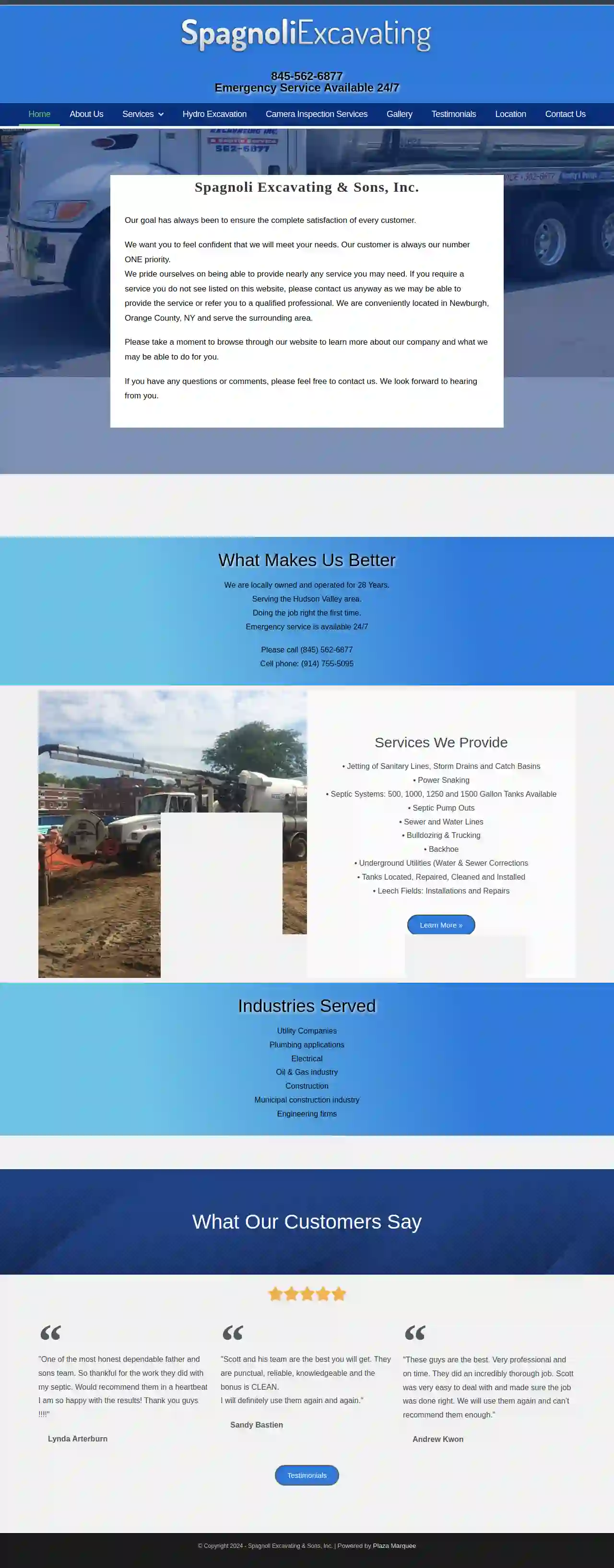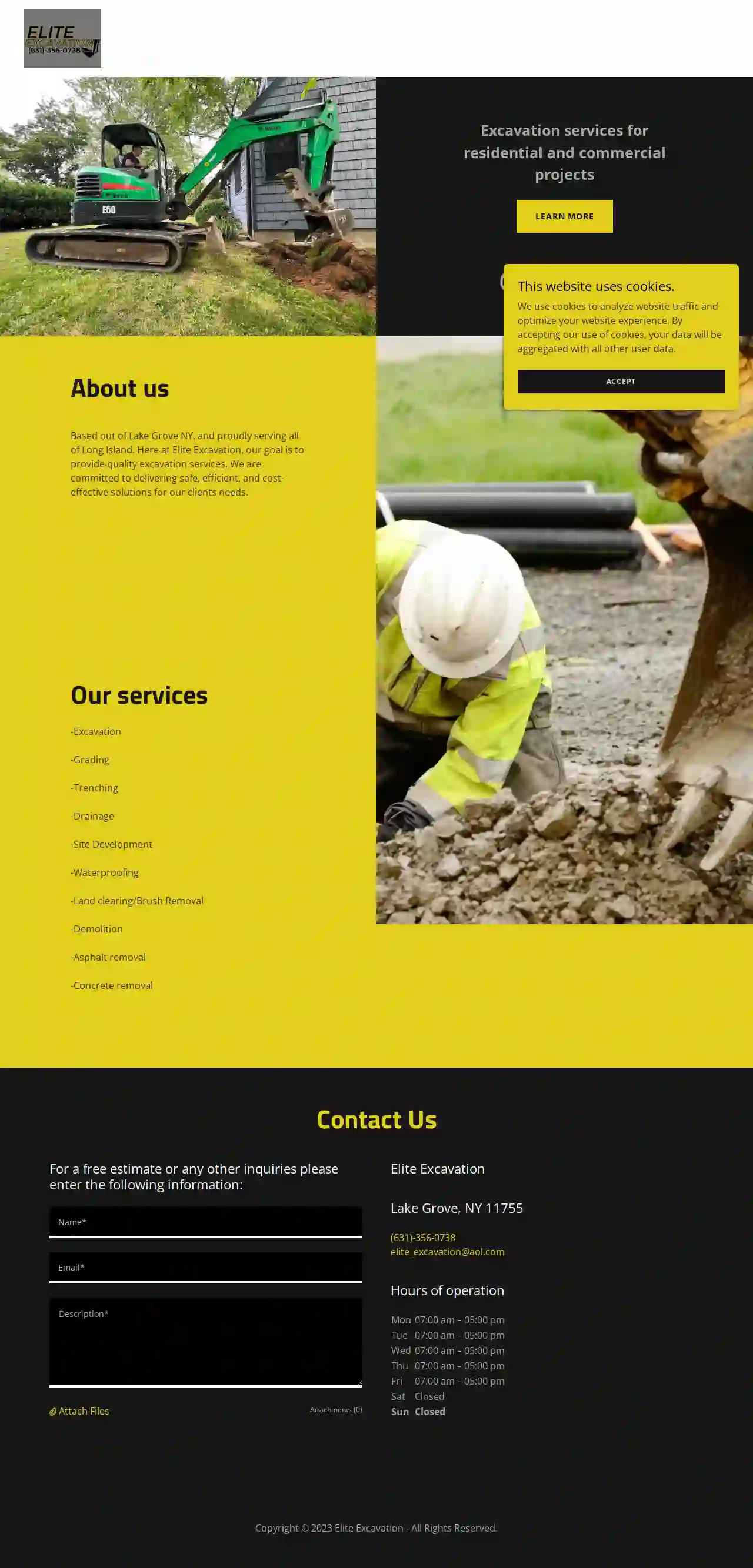Demolition Contractors Port Jervis
Find top Demolition Companies in Port Jervis
Get up to 3 Structure Demolition quotes for your project today! Compare profiles, reviews, accreditations, portfolio, etc... and choose the best service.

LONG ISLAND EXCAVATION
240 Elwood Road, East Northport, 11731, USBongiorno's Contracting Professional groundwork and excavation service from one of the leading construction excavation companies in New York. There is a lot more to groundwork than just moving earth. Our extensive experience ensures that all concerns and laws relating to the environment, civil engineering and health and safety are taken into account to give you peace of mind. Reasons for Choosing Our Company Established 70 years in business on Long Island Licensed and Insured Home Improvement Contractors No Sub-Contracting, All the work is done by our team Many Recent Job References Family Owned and Operated Using only quality materials Forms of Payments Excepted: Credit Cards (VISA, Mastercard, American Express, Discover), Personal checks, Cashier Checks. Suffolk County Home Improvement License 9615-H Our Team (Left to Right) Charles F. Bongiorno 111 - Charles F. Bongiorno Jr. - Charles F. Bongiorno Sr. Corporate Office Chuck Bongiorno As. Bs. Ms. 240 Elwood Road East Northport, New York 11731 Business Phone: (631) 368-9086 Cell Phone: (631) 848-3190 Yard: (631) 368-8123 Email: [email protected]
- Services
- Why Us?
- Our Team
- Gallery
Get Quote
Ground Control Excavating Inc.
3.73 reviewsWarwick, USComplete Site Development, Excavation, & More… We provide complete land and site development services for projects of all sizes, including government, commercial, public, private, emergency, and residential projects. Ground Control Excavating, Inc. offers complete excavation services for residential and commercial projects. A premiere land-site excavating contractor, as well as, first-responder for emergencies and natural disasters in the NY area, we are committed to providing the highest level of quality to our customers throughout Orange, Sullivan, Rockland, Westchester counties and the entire Hudson Valley, NY area. GCE is based out of Warwick, NY. We provide complete site development, road development, rock hammering, rock crushing, concrete recycling, underground utilities, septic systems, drainage, top soil, and much more. We service Warwick, Monroe, Middletown, Goshen, Newburgh and the entire Hudson Valley. Experienced Construction Professionals We will work with you to achieve a common goal on time and on budget!
- Services
- Why Us?
- Gallery
Get Quote
CW Earthworks
52 reviews1614 Grimball Rd Ext, Charleston, 29412, USCW Earthworks, LLC We are a landscape construction company with the vision of a green future. Our mission is to operate from the position that Earth is Life. We strive to meet the needs of all customers while serving Mother Nature best in all situations. We have the ability to complete a multi-faceted project for residential and commercial clients from start to finish. About Us CW Earthworks began with the green vision of a small company equipped to complete big jobs. The Lowcountry dirt and salt is in our blood. Our team has a "generalist" mindset, and we use our broad skillset to efficiently achieve the desired vision for every job. Time in Nature defines our lives and work is also play. We value our community and we approach every situation as a new opportunity. Hire us to improve your land and take your vision to the next level! Thank You
- Services
- Why Us?
- Testimonials
- Gallery
Get Quote
Site Right Excavation, LLC
123 Main Street, Anytown, 12345, USSite Right Excavation: Your Trusted Partner for Excavation Services Site Right Excavation is a family-owned and operated business with over 20 years of experience in the excavation industry. We are committed to providing our clients with high-quality, reliable, and affordable excavation services. Our team of experienced professionals is dedicated to exceeding your expectations and delivering exceptional results. We understand that every project is unique, and we take the time to listen to your needs and develop a customized plan that meets your specific requirements. Whether you need site preparation, foundation excavation, utility installation, or any other excavation service, we have the expertise and equipment to get the job done right. At Site Right Excavation, we are committed to safety and environmental responsibility. We use the latest technology and equipment to ensure that our projects are completed safely and efficiently. We also strive to minimize our environmental impact by using sustainable practices and recycling materials whenever possible. Contact us today to schedule a free consultation and learn more about how we can help you with your next excavation project.
- Services
- Why Us?
- Testimonials
Get Quote
Spagnoli Excavating Inc
517 reviews47 South Plank Road, Newburgh, 12550, USSpagnoli Excavating & Sons, Inc. At Spagnoli Excavating & Sons, Inc., our unwavering commitment is to ensure the complete satisfaction of every customer. We strive to provide you with the confidence that your needs will be met, placing our customers as our top priority. We take pride in offering a wide range of services to cater to your diverse requirements. If you need a service not listed on our website, don't hesitate to contact us. We may be able to assist you or refer you to a qualified professional. Conveniently located in Newburgh, Orange County, NY, we serve the surrounding area. Explore our website to learn more about our company and the services we can provide. Feel free to reach out with any questions or comments. We look forward to hearing from you.
- Services
- Why Us?
- Testimonials
- Gallery
Get Quote
Carolina Excavation Specialties LLC
528 reviewsGarner, NC, 27529, USUnparalleled Excavation Services & Solutions The Excavation & Grading Team You Can Rely On! PREMIER EXCAVATION CONTRACTOR Proudly Serving Apex, NC; Chapel Hill, NC; Raleigh, NC; and Youngsville, NC If you’re looking for a hardworking, dedicated team of excavation and grading contractors to tackle your excavation job, you’ve come to the right place! Carolina Excavation Specialties LLC is an authority in the industry that provides a comprehensive list of excavation services and more for residential and commercial properties throughout the Apex, NC; Chapel Hill, NC; Raleigh, NC; and Youngsville, NC areas. These services include: ● Excavation ● Utilities ● Septic System Install & Repairs ● Culverts, Ditching & Storm Drainage ● Demolition Services ● Erosion Control ● Retention Ponds ● Grading ● Gravel Pads & Driveways ● Land Clearing ● Foundations ● Retaining Walls ● Roof Drainage ● Asphalt/Concrete More About Us
- Services
- Why Us?
- Our Team
- Testimonials
- Gallery
Get Quote
Elite Excavation
51 reviewsLake Grove, NY, 11755, USAbout us Based out of Lake Grove NY, and proudly serving all of Long Island. Here at Elite Excavation, our goal is to provide quality excavation services. We are committed to delivering safe, efficient, and cost-effective solutions for our clients' needs.
- Services
- Why Us?
- Gallery
Get Quote- Mc
McNeight Excavating
4.824 reviewsBuffalo, USWe are a family-owned and operated excavating company serving the [CITY] area. We have been in business for over 20 years and have a proven track record of providing high-quality services at competitive prices. We specialize in a wide range of excavating services, including site preparation, foundation work, utility installation, and more. We are committed to providing our clients with the highest level of customer service and satisfaction. We are fully insured and bonded, and we use only the latest equipment and technology to ensure that all of our projects are completed on time and within budget. Contact us today for a free estimate.
- Services
- Why Us?
- Gallery
Get Quote 
The State Group Industrial USA Ltd
54 reviews810 Crescent Centre Drive, Suite 280, 810 Crescent Centre Drive Suite 280, Franklin, 37067, USThe State Group: Mission Critical Multi-Trade Services For over 60 years, The State Group has been a leading multi-trade service contractor on projects, maintenance, and service throughout the United States and Canada. We are committed to providing our clients with the highest quality services, delivered safely and efficiently. Our team of highly skilled professionals has a wealth of experience in a diverse range of industries, including power, renewable energy, electric vehicle/automotive, mission critical, manufacturing, metals & mining, energy, chemical processing, food and beverage processing, and commercial and institutional. Our Values Our values are the foundation of everything we do. We are committed to: Safety: Our commitment is Everyone Goes Home Safe. Quality: We strive for excellence in everything we do. Integrity: We are honest and ethical in all our dealings. Teamwork: We work together to achieve our goals. Innovation: We are constantly seeking new and better ways to serve our clients. Our People Our people are our greatest asset. We are committed to providing our employees with a safe and rewarding work environment. We offer competitive salaries and benefits, as well as opportunities for professional development. If you are looking for a challenging and rewarding career, we encourage you to apply.
- Services
- Why Us?
- Gallery
Get Quote
Blythe Construction Inc
4.121 reviews2911 North Graham Street, Charlotte, 28206, USBuilding Together with our clients, communities, and stakeholders. Building Leadership to take on tomorrow’s challenges. Building Performance by integrating operations, production and trade. Building Communities to thrive for generations to come. Blythe Construction Blythe Construction is the southeastern United States’ leading heavy construction firm. We proudly serve our communities by building state-of-the-art roads, bridges, railways, and commercial centers. Our expert teams have engineered many of the region’s most advanced infrastructure projects, and completed thousands of private development contracts that enhance the lives of millions of Americans every day. Our construction and paving teams are committed to delivering high-quality services on time, on budget, and engineered to provide maximum value to our clients in both the public and private markets. Whether we’re building Charlotte’s I-485 outer loop, or developing the site of a local commercial establishment, Blythe Construction uses the latest industry technology and practices to guarantee quality on every level of our operations. At Blythe Construction, we’re building our country’s bright future. The work we do plays a continuing role in growing our local communities and improving our shared infrastructure. Our company employs hundreds of highly skilled employees, each of whom is dedicated to our culture of excellence. Together, we are working to ensure the success of Blythe Construction and the Southeast for generations to come.
- Services
- Why Us?
- Gallery
Get Quote
Over 22,076+ Excavation Businesses in our network
Our excavation pros operate in Port Jervis & beyond!
ExcavationHQ has curated and vetted Top Excavation Contractors arround Port Jervis. Find a reliable pro today.
Frequently Asked Questions About Demolition Contractors
- 'Can I see proof of your licensing and insurance?' Verify their credentials and coverage.
- 'What experience do you have with projects like mine?' Ensure they have relevant expertise.
- 'Can you provide references from past clients?' Check their reputation and customer satisfaction.
- 'What are your safety protocols?' Prioritize contractors who emphasize safety.
- 'How will you handle hazardous materials?' Ensure they have proper procedures for asbestos or lead abatement.
- 'What is your timeline for completing the project?' Understand the project duration.
- 'How will you manage noise, dust, and debris?' Discuss mitigation measures for minimizing disruption.
- 'What are your payment terms?' Clarify payment schedules and any required deposits.
- Experience: Look for companies with a proven track record and years of experience in the demolition industry.
- Licensing and Insurance: Ensure the contractor is properly licensed to operate in your area and carries adequate insurance to protect you from liability.
- Safety Record: Inquire about their safety protocols and accident history. A reputable contractor prioritizes safety.
- References and Reviews: Ask for references from past clients and check online reviews to gauge their reputation and customer satisfaction.
- Professionalism: Choose a company that communicates clearly, provides detailed estimates, and has a courteous and responsive team.
- Permits and Regulations: Obtain all necessary demolition permits and comply with local building codes and environmental regulations.
- Contracts: Have a clear and comprehensive contract with the demolition contractor outlining the scope of work, payment terms, and liabilities.
- Environmental Laws: Comply with environmental laws regarding hazardous material removal, waste disposal, and pollution control.
- Neighboring Property Rights: Respect neighboring property rights and take measures to prevent damage or disruption to adjacent properties.
- Worker Safety: Adhere to worker safety regulations and provide a safe working environment for demolition crews.
What questions should I ask a demolition contractor before hiring them?
Can I do demolition myself?
How do I find a reputable demolition contractor?
What are the legal considerations for demolition projects?
What questions should I ask a demolition contractor before hiring them?
- 'Can I see proof of your licensing and insurance?' Verify their credentials and coverage.
- 'What experience do you have with projects like mine?' Ensure they have relevant expertise.
- 'Can you provide references from past clients?' Check their reputation and customer satisfaction.
- 'What are your safety protocols?' Prioritize contractors who emphasize safety.
- 'How will you handle hazardous materials?' Ensure they have proper procedures for asbestos or lead abatement.
- 'What is your timeline for completing the project?' Understand the project duration.
- 'How will you manage noise, dust, and debris?' Discuss mitigation measures for minimizing disruption.
- 'What are your payment terms?' Clarify payment schedules and any required deposits.
Can I do demolition myself?
How do I find a reputable demolition contractor?
- Experience: Look for companies with a proven track record and years of experience in the demolition industry.
- Licensing and Insurance: Ensure the contractor is properly licensed to operate in your area and carries adequate insurance to protect you from liability.
- Safety Record: Inquire about their safety protocols and accident history. A reputable contractor prioritizes safety.
- References and Reviews: Ask for references from past clients and check online reviews to gauge their reputation and customer satisfaction.
- Professionalism: Choose a company that communicates clearly, provides detailed estimates, and has a courteous and responsive team.
What are the legal considerations for demolition projects?
- Permits and Regulations: Obtain all necessary demolition permits and comply with local building codes and environmental regulations.
- Contracts: Have a clear and comprehensive contract with the demolition contractor outlining the scope of work, payment terms, and liabilities.
- Environmental Laws: Comply with environmental laws regarding hazardous material removal, waste disposal, and pollution control.
- Neighboring Property Rights: Respect neighboring property rights and take measures to prevent damage or disruption to adjacent properties.
- Worker Safety: Adhere to worker safety regulations and provide a safe working environment for demolition crews.